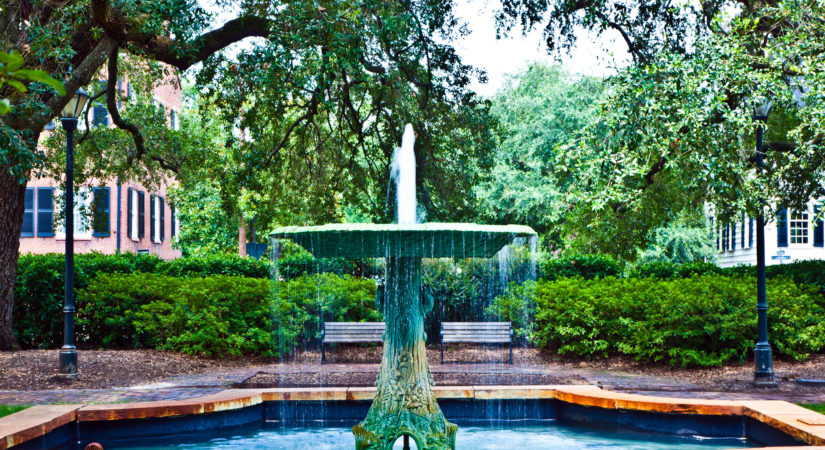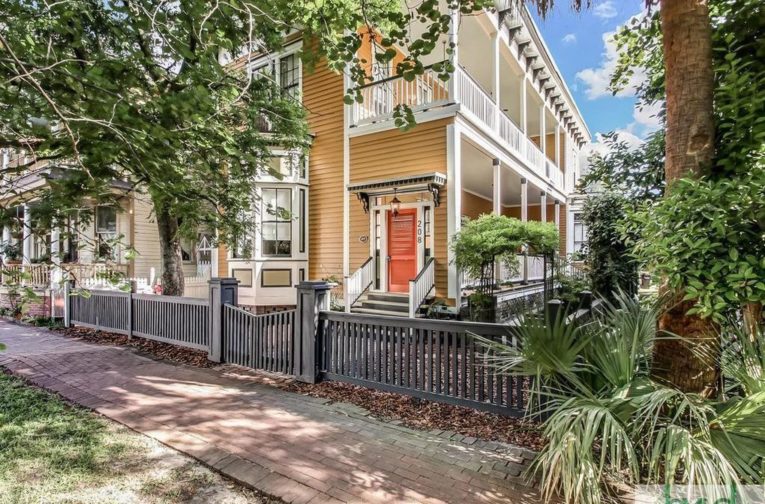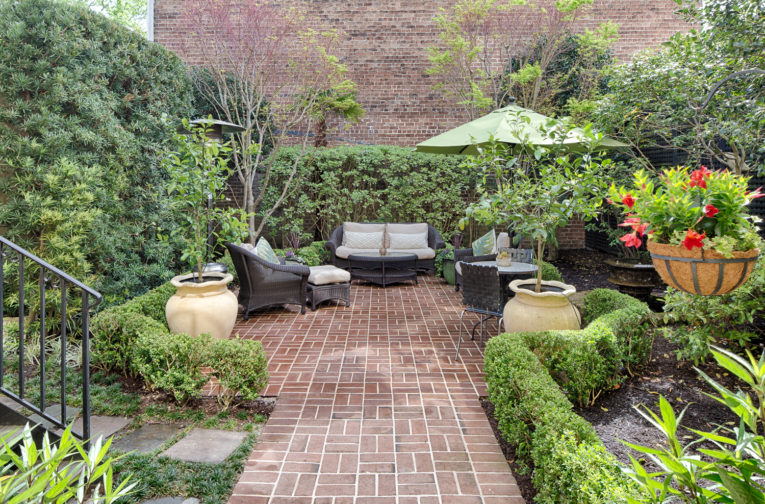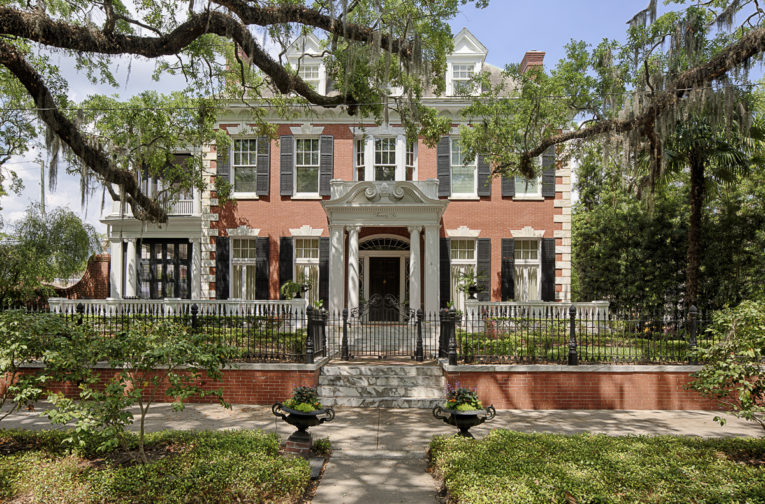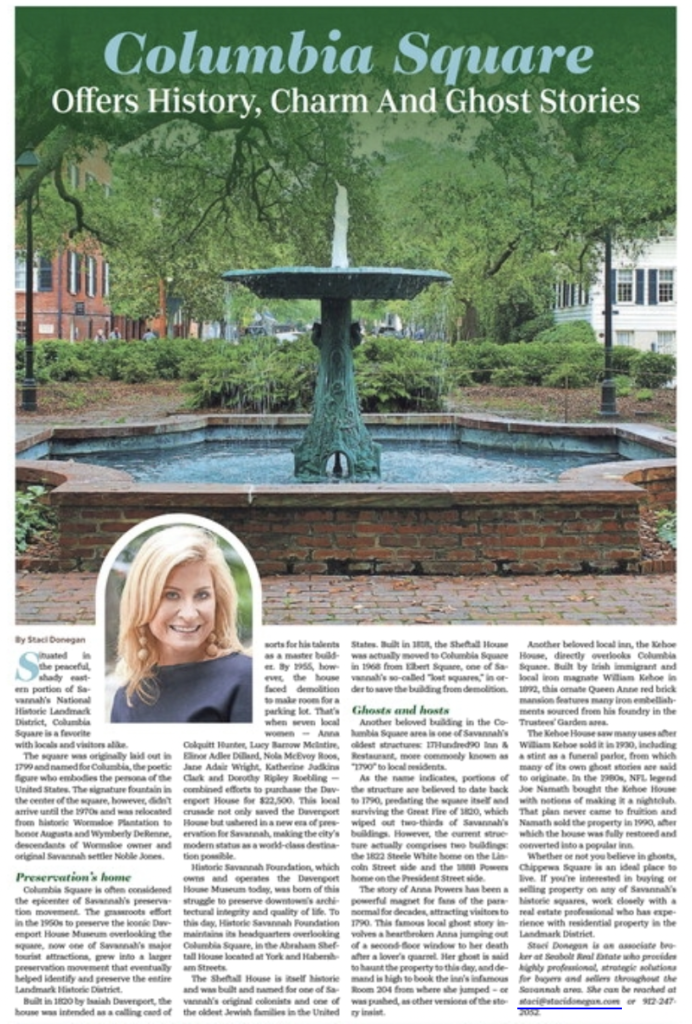
Situated in the peaceful, shady eastern portion of Savannah’s National Historic Landmark District, Columbia Square is a favorite with locals and visitors alike.
The square was originally laid out in 1799 and named for Columbia, the poetic figure who embodies the persona of the United States. The signature fountain in the center of the square, however, didn’t arrive until the 1970s and was relocated from historic Wormsloe Plantation to honor Augusta and Wymberly DeRenne, descendants of Wormsloe owner and original Savannah settler Noble Jones.
PRESERVATION’S HOME
Columbia Square is often considered the epicenter of Savannah’s preservation movement. The grassroots effort in the 1950s to preserve the iconic Davenport House Museum overlooking the square, now one of Savannah’s major tourist attractions, grew into a larger preservation movement that eventually helped identify and preserve the entire Landmark Historic District.
Built in 1820 by Isaiah Davenport, the house was intended as a calling card of sorts for his talents as a master builder. By 1955, however, the house faced demolition to make room for a parking lot. That’s when seven local women — Anna Colquitt Hunter, Lucy Barrow McIntire, Elinor Adler Dillard, Nola McEvoy Roos, Jane Adair Wright, Katherine Judkins Clark and Dorothy Ripley Roebling — combined efforts to purchase the Davenport House for $22,500. This local crusade not only saved the Davenport House but ushered in a new era of preservation for Savannah, making the city’s modern status as a world-class destination possible.
Historic Savannah Foundation, which owns and operates the Davenport House Museum today, was born of this struggle to preserve downtown’s architectural integrity and quality of life. To this day, Historic Savannah Foundation maintains its headquarters overlooking Columbia Square, in the Abraham Sheftall House located at York and Habersham Streets.
The Sheftall House is itself historic and was built and named for one of Savannah’s original colonists and one of the oldest Jewish families in the United States. Built in 1818, the Sheftall House was actually moved to Columbia Square in 1968 from Elbert Square, one of Savannah’s so-called “lost squares,” in order to save the building from demolition.
GHOSTS AND HOSTS
Another beloved building in the Columbia Square area is one of Savannah’s oldest structures: 17Hundred90 Inn & Restaurant, more commonly known as “1790” to local residents.
As the name indicates, portions of the structure are believed to date back to 1790, predating the square itself and surviving the Great Fire of 1820, which wiped out two-thirds of Savannah’s buildings. However, the current structure actually comprises two buildings: the 1822 Steele White home on the Lincoln Street side and the 1888 Powers home on the President Street side.
The story of Anna Powers has been a powerful magnet for fans of the paranormal for decades, attracting visitors to 1790. This famous local ghost story involves a heartbroken Anna jumping out of a second-floor window to her death after a lover’s quarrel. Her ghost is said to haunt the property to this day, and demand is high to book the inn’s infamous Room 204 from where she jumped – or was pushed, as other versions of the story insist.
Another beloved local inn, the Kehoe House, directly overlooks Columbia Square. Built by Irish immigrant and local iron magnate William Kehoe in 1892, this ornate Queen Anne red brick mansion features many iron embellishments sourced from his foundry in the Trustees’ Garden area.
The Kehoe House saw many uses after William Kehoe sold it in 1930, including a stint as a funeral parlor, from which many of its own ghost stories are said to originate. In the 1980s, NFL legend Joe Namath bought the Kehoe House with notions of making it a nightclub. That plan never came to fruition and Namath sold the property in 1990, after which the house was fully restored and converted into a popular inn.
Whether or not you believe in ghosts, Columbia Square is an ideal place to live. If you’re interested in buying or selling property on any of Savannah’s historic squares, work closely with a real estate professional who has experience with residential property in the Landmark District.

